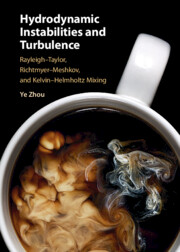 Hydrodynamic Instabilities and Turbulence
Hydrodynamic Instabilities and Turbulence from Part 2 - Hydrodynamics of Complex Flows
For analytical simplicity, most research to date on RT and RM instabilities has focused on planar geometries. Such a simplified design is very helpful in easing the diagnostic requirements for laboratory experiments. However, in our limited observations of Chapter 15, we have already witnessed that other geometric configurations may alter the mixing layer growth significantly. In a variety of important applications, one must deal with imploding/exploding flows, the prime examples of which are inertial confinement fusion implosions (convergent geometry) and supernova explosions (divergent geometry). In these configurations, the flows are radially accelerated/decelerated. In contrast to planar geometry, where only RM growth is expected to occur, converging/diverging shock-accelerated interfaces can be RT unstable as they geometrically contract or expand. In the experiments and analytical modeling in this chapter, the amplitude growth depends on the convergence history in a complicated way.
To save this book to your Kindle, first ensure [email protected] is added to your Approved Personal Document E-mail List under your Personal Document Settings on the Manage Your Content and Devices page of your Amazon account. Then enter the ‘name’ part of your Kindle email address below. Find out more about saving to your Kindle.
Note you can select to save to either the @free.kindle.com or @kindle.com variations. ‘@free.kindle.com’ emails are free but can only be saved to your device when it is connected to wi-fi. ‘@kindle.com’ emails can be delivered even when you are not connected to wi-fi, but note that service fees apply.
Find out more about the Kindle Personal Document Service.
To save content items to your account, please confirm that you agree to abide by our usage policies. If this is the first time you use this feature, you will be asked to authorise Cambridge Core to connect with your account. Find out more about saving content to Dropbox.
To save content items to your account, please confirm that you agree to abide by our usage policies. If this is the first time you use this feature, you will be asked to authorise Cambridge Core to connect with your account. Find out more about saving content to Google Drive.